-
Posts
2,351 -
Joined
-
Last visited
Content Type
Profiles
Forums
Store
Help Articles
Posts posted by Patrick S
-
-
I have used the lemon juice method to make a substitute for corn syrup, and it seemed to work fine. And while acid hydrolysis can be used to create an almost completely "inverted" syrup, the process would not be easy to do at home, and requires too much acid to be palatable (not so much a problem in a manufacturing system where the acid can be neutralized and removed after the inversion process). And for some reason, the process tends to produce a syrup that is not 50/50 as you would expect, but somehow contains disproportionately more fructose.
Here is a link to an old paper (~1945) that examines many of the variables involved in producing inverted sugar using the acid method:
-
I think Jean Philippe Patisserie at Bellagio has something like what your talking about
Their cases are open in the back, but covered on top and in front.
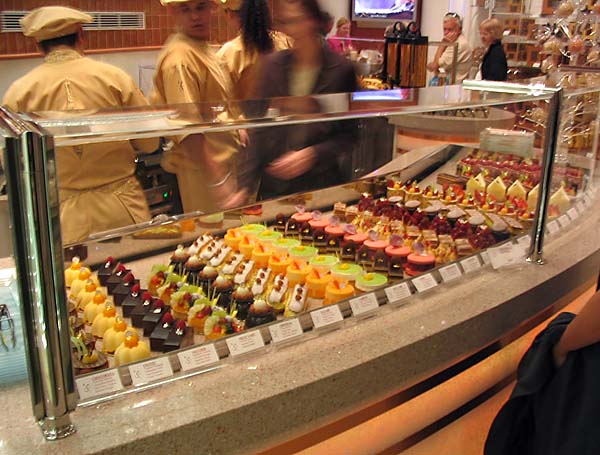
-
I made a passion fruit curd once, using a frozen sweetened puree. I made little tartlets with little discs of banana cake, topped by strawberry jam, topped with the curd.
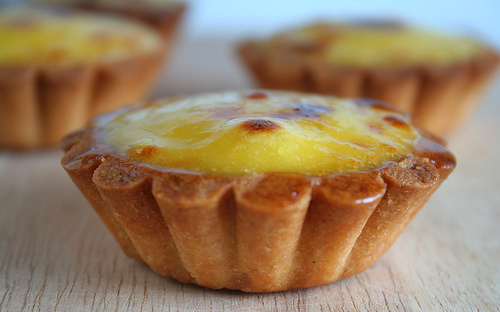
Mine turned out a little too sweet, but were still good. I was trying to duplicate something called the tart Maeva I had at Vanille Patisserie in Chicago, which was delicious.
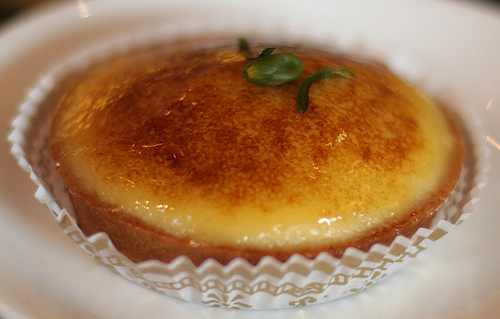
-
Some cake decorating stores carry it too.
-
I'd like to try Dutched now but can't find it in my town. The closest I saw was Hershey's Dark which says it is a mix of Dutch and non-Dutch. Do many of you order yours online (I'm a home baker so don't need a huge quantity)? I live in a medium sized town with a few different grocery store options. What brand would I be looking for? Thanks!
If you do decide to order online, you can get a 1kg bag of Callebaut for $20 from ChocolateSource.com.
-
The hot fudge pudding cake from Cook's Country is quick, easy and pretty delicious.
-
I have no idea. My thermometer doesn't take temps below 190F. Note to self: Why didn't you look more closely at it before you bought it?
Well, if the problem is not failure to disperse the eggs into the other ingredients --and I doubt it is if you are mixing the eggs with the sugar first-- then the coagulated bits are probably a result of overcooking.
-
A few questions:
Is it possible to make a curd without the egg white coagulating? Or is something I should just deal with and sieve all my curds?
Thanks!
By the way, lemon curd cheesecake bars Are Good Things.

If you beat the eggs really well before you add the other ingredients, that will help. Your eggs should be beaten as if you used an immersion blender and the curd will come out nice and smooth.
Or, beat the eggs with the sugar before adding the other ingredients. This makes for a more viscous mixture, which helps the egg whites get evenly dispersed. Thinking literally about it, of course, you actually want the egg whites to coagulate to some extent -- that's what forms the gel that makes a curd thicken and become a curd, as opposed to a sauce. You just want the egg to be evenly dispersed before it coagulates, and control the degree to which coagulation occurs.
That's what I've been doing, actually, but I still got a lot of coagulated egg whites (not curd)--at least, it seemed a lot to me, since it was only the second time that I've made lemon curd. Which was why I asked.
Hmm. What temperature are you cooking your curd to?
-
Has anyone tried Sherry Yard's "Secrets of Baking" Chocolate Chip Cookie recipe before? I loved the chewy result, but was wondering if there was maybe a typo in the book with regards to the sugar content as they were very sweet. The conversation I had with someone about them was something along the lines of :
Him: These cookies are nice, but they are desperately sweet.
Me: Yes, they are a bit sweet....
Him: No, not a bit sweet, desperately sweet!
I haven't tried them, but the recipe does look a little sweet. Plus it seems to have very little salt to balance out the sugar -- 1/4t salt to 1.25C of sugars.
-
A few questions:
Is it possible to make a curd without the egg white coagulating? Or is something I should just deal with and sieve all my curds?
Thanks!
By the way, lemon curd cheesecake bars Are Good Things.

If you beat the eggs really well before you add the other ingredients, that will help. Your eggs should be beaten as if you used an immersion blender and the curd will come out nice and smooth.
Or, beat the eggs with the sugar before adding the other ingredients. This makes for a more viscous mixture, which helps the egg whites get evenly dispersed. Thinking literally about it, of course, you actually want the egg whites to coagulate to some extent -- that's what forms the gel that makes a curd thicken and become a curd, as opposed to a sauce. You just want the egg to be evenly dispersed before it coagulates, and control the degree to which coagulation occurs.
-
Curious that Jacques mixes almost equal amounts pastry and bread flower. Isn't that a bit like making all purpose flower?
It would seem so. Wikipedia gives the following values for flour protein content:
9-10% Pastry Flour
10-11.5% All-Purpose Flour
11-13% Bread Flour
If those values are correct, then a 50/50 mixture of pastry and bread flour would have between 10 and 11.5% protein, exactly the range given for AP flour. Since pastry flour is made from soft wheat, bread flour from hard wheat, and AP flour from a mixture of both, mixing pastry and bread flour is just like making AP flour.
-
I don't know much about ganache but I do know a little about solvents and I think it should be theoretically possible to extract essential oils from fruit using something really volatile and then distill it off...I just don't know how to do this in a kitchen setting.
I'm thinking something like butane would do the trick, but there are still issues: you'd want to be very careful to get rid of all the butane, which shouldn't be that much of an issue, but then you're dealing with flammable gases.....you know, this whole thing is just a really bad idea.
Sorry I couldn't be more help, but the more I think about it the more I wouldn't want to even try this in a kitchen.

I agree that it would be a bad idea. Aside from the fact that you could kill or injure yourself if there was an accidental ignition, most butane has impurities in it that you probably wouldn't want to consume. You can demonstrate this with the mirror test -- discharge a butane can onto a mirror and wait for the butane to evaporate off, usually you'll see some white residue left behind. I don't know what this petrochemical residue is, but I doubt that consuming it would be a good idea.
-
I'm curious as to what food safety concerns we're talking about here? The issue with the plastic wrap touching hot cakes and thus possibly producing dioxins? Or are we talking bacterial/mold growth?
As for plastics touching hot cakes, if you immediately unmold the cake right away after taking it out of the oven and wrapping it right away, there might be a possibility of dioxins being released by the plastic wrap (the verdict is still out there on this issue, right?).
No, the verdict has been in for years -- plastic wraps do not contain dioxins and therefore can not leach them into food. Further, most wraps are made of polyethylene or polypropylene, which do not contain chlorine and do not produce dioxins even when incinerated.
-
I was inspired by Patrick's photographs, and my brioche dough is now resting in the refrigerator. But I don't think it'll turn out the way it was intended. It didn't seem to really come together, it stayed kind of shaggy, curdled looking and way too wet, even after the specified beating time. I added few tablespoons of flour, one tablespoon at a time, hoping it would come together into a smooth silky dough... but no such luck.
Anyway after the rising and slapping down it is still sticky and in fact quite oily. Is it supposed to be this way? Should I go ahead and bake it up tomorrow or is it beyond redemption and should I not waste time and face certain disaster?
The dough shouldn't look shaggy, and I don't know what went wrong there, but its normal for brioche dough to be a little sticky and look and feel more wet than a dough with much less fat, so thats not necessarily a bad sign. Once you refrigerate the dough, it will get firmer and be easier to handle and shape. If I were you, I'd just proceed with your recipe. It may not turn out picture perfect, but unless something's gone really, really wrong, you're still likely to end up with something delicious.
-
When your spring-form pan does not have an airtight seal, what compensations do you make?
Should I line it? Hope for the best with heavy coating of EVOO and breadcrumbs? Or play it safe with a regular pie tin?
I have a talented baking friend who addresses leaky springforms in this manner: cut a piece of parchment larger than the bottom of the pan; place the parchment over the bottom disk while the pan is disassembled, and reassemble the pan while catching the overhang of parchment between the ring and the disk. My friend swears it works, but I' haven't tested it yet.
That's what I was suggesting also, though I didnt explain it as clearly as you did. It works fine if you have a tiny gap, plus it makes it easy to transfer the food.
-
When your spring-form pan does not have an airtight seal, what compensations do you make?
Should I line it? Hope for the best with heavy coating of EVOO and breadcrumbs? Or play it safe with a regular pie tin?
This is a vegetable torta*, so it's bulky, but there are 3 eggs and a little sour cream.
*pound of finely chopped green beans, mushrooms...
The breadcrumb and EVOO idea is a good one. I'd use the bottom of a measuring cup or ramekin to really press the crumbs down firmly, and make a better seal. Depending on how bad the seal is, another thing you can try is laying a sheet of parchment over the bottom of the pan before clamping the top on. If its a tiny leak, that could seal it.
-
Having used half of my brioche batch to make the sticky buns, I made a loaf with the other half. I had a slice this morning, toasted, with some strawberry ham.
couldn't resist patrick!

I'll let you in on a little secret -- strawberry ham is the next big fad in molecular gastronomy. It will be appearing on the menu at Alinea next month

-
Having used half of my brioche batch to make the sticky buns, I made a loaf with the other half. I had a slice this morning, toasted, with some strawberry ham.
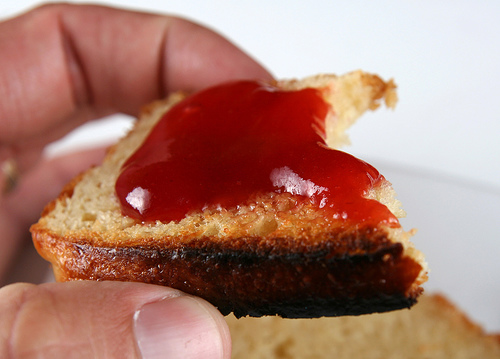
Larger image on Flickr:
-
-
I am wondering if making a dry caramel ,would help with humidity issues.Probably not much ,but I was thinking that might be something you can use to keep the caramel from sticking.
I also doubt that it would make any difference, because whether you start from a very dilute syrup or from dry sugar, you're going to end up with the same amount of water by the time you get to caramel temperatures. Effectively all of the water will have been boiled off before the sugar will start to caramelize at ~320F.
-
I've also been following this thread for many months now -- I've done the basic recipe but after reading all the wonderful variations you very talented folks have done, I think I'm ready to branch out with some banana ones -- has anyone actually made these? There seems to be some talk about theory on what to do but I don't recall seeing any 'been there-done that'.
-
I've been dieting for a couple of months, and have pretty much completely deprived myself of desserts. This week I reached my target weight, and decided to celebrate with some doughnuts. These were filled with strawberry jam. Recipe here.

-
I am hoping to make strawberry marshmallows tomorrow. I like things sweet/tart. I will dip the tops in chocolate.
What do you think about adding some "sour salt", which is pure citric acid. How much do you think in one batch, and when would I add it?
Those of you that use lemon juice, when and how?
Thanks!
Hi Becca,
I would think that the best way to add the citric acid would be to add it to the water that you use to bloom the gelatin. I don't know how much you should use, but for a point of reference, there is 1g of citric acid in 20ml (4 teaspoons) of lemon juice, so 1g of citric acid should give you the equivalent acidic boost that you'd get from 4t of lemon juice.
-
I don't have any tips for stabilizing the souffles, but what I do is, set up the shoot while they are baking, using a stand-in of some kind for the souffle so I can get the exposure and lighting the way I want. Then, when the souffles are ready, I can take them out, swap out the dummy, and immediately and get the shot I want before they deflate.



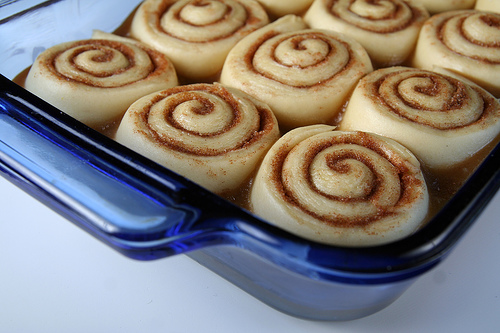
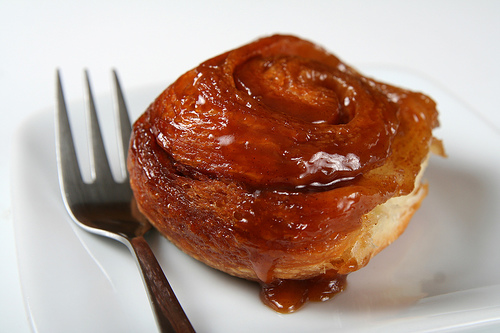
"Baking: From My Home to Yours" (Part 2)
in Pastry & Baking
Posted
Agreed. Best sticky buns ever, I say.